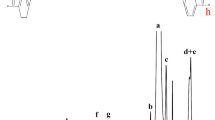Abstract
An acryloyl end-capped four-arm star-shaped poly(ethylene glycol)-branched-oligo(l-lactide) (4A-PEG-PLA) macromer was firstly prepared. A novel kind of hydrogels was synthesized via the Michael-type addition reaction between (2S,3S)-1,4-bis-sulfanylbutane-2,3-diol (dithiothreitol) and this macromer. Gelation time was determined visually as the time when the precursor solution did not flow on inverting the vials. Hydrogel structure was characterized by FTIR analysis, swelling and degradation tests. It was found that colorless and transparent hydrogels were quickly generated in situ. The gelation time, swelling and degradation behaviors of this kind of hydrogels could be adjusted by changing the concentration of the macromer solution in PBS buffer (pH 7.4). This novel hydrogel is expected to be used as a biomedical material.
Similar content being viewed by others
References
Bočková, J., Vojtová L., Přikryl, R., Čechal, J., & Jančř J. (2008). Collagen-grafted ultra-high molecular weight polyethylene for biomedical applications. Chemical Papers, 62, 580–588. DOI: do]10.2478/s11696-008-0076-1.
Cai, S., Liu, Y., Shu, X. Z., & Prestwich, G. D. (2005). Injectable glycosaminoglycan hydrogels for controlled release of human basic fibroblast growth factor. Biomaterials, 26, 6054–6067. DOI: 10.1016/j.biomaterials.2005.03.012.
Chenite, A., Chaput, C., Wang, D., Combes, C., Buschmann, M. D., Hoemann, C. D., Leroux, J. C., Atkinson, B. L., Binette, F., & Selmani, A. (2000). Novel injectable neutral so lutions of chitosan form biodegradable gels in situ. Biomaterials, 21, 2155–2161. DOI: 10.1016/S0142-9612(00)00116-2.
de Jong, S. J., De Smedt, S. C., Demeester, J., van Nostrum, C. F., Kettenes-van den Bosch, J. J., & Hennink, W. E. (2001). Biodegradable hydrogels based on stereocomplex formation between lactic acid oligomers grafted to dextran. Journal of Controlled Release, 72, 47–56. DOI: 10.1016/S0168-3659(01)00261-9.
Elbert, D. L., Pratt, A. B., Lutolf, M. P., Halstenberg, S., & Hubbell, J. A. (2001). Protein delivery from materials formed by self-selective conjugate addition reactions. Journal of Controlled Release, 76, 11–25. DOI: 10.1016/S0168-3659(01)00398-4.
Friedman, M., Cavins, J. F., & Wall, J. S. (1965). Relative nucleophilic reactivities of amino groups and mercaptide ions in addition reactions with α,β-unsaturated compounds. Journal of the American Chemical Society, 87, 3672–3682. DOI: 10.1021/ja01094a025.
Hennink, W. E., & van Nostrum, C. F. (2002). Novel crosslinking methods to design hydrogels. Advanced Drug Delivery Reviews, 54, 13–36. DOI: 10.1016/S0169-409X(01)00240-X.
Kissel, T., Li, Y., & Unger, F. (2002). ABA-triblock copolymers from biodegradable polyester A-blocks and hydrophilic poly(ethylene oxide) B-blocks as a candidate for in situ forming hydrogel delivery systems for proteins. Advanced Drug Delivery Reviews, 54, 99–134. DOI: 10.1016/S0169-409X(01)00244-7.
Lutolf, M. P., & Hubbell, J. A. (2003). Synthesis and physicochemical characterization of end-linked poly(ethylene glycol)-co-peptide hydrogels formed by Michael-type addition. Biomacromolecules, 4, 713–722. DOI: 10.1021/bm025744e.
Mather, B. D., Viswanathan, K., Miller, K. M., & Long, T. E. (2006). Michael addition reactions in macromolecular design for emerging technologies. Progress in Polymer Science, 31, 487–531. DOI: 10.1016/j.progpolymsci.2006.03.001.
Metters, A., & Hubbell, J. (2005). Network formation and degradation behavior of hydrogels formed by Michael-type addition reactions. Biomacromolecules, 6, 290–301. DOI: 10.1021/bm049607o.
Peppas, N. A., Bures, P., Leobandun, W., & Ichikawa, H. (2000). Hydrogels in pharmaceutical formulations. European Journal of Pharmaceutics and Biopharmaceutics, 50, 27–46. DOI: 10.1016/S0939-6411(00)00090-4.
Sawhney, A. S., Pathak, C. P., & Hubbell, J. A. (1993). Bioerodible hydrogels based on photopolymerized poly(ethylene glycol)-co-poly(α-hydroxy acid) diacrylate macromers. Macromolecules, 26, 581–587. DOI: 10.1021/ma00056a005.
Schoenmakers, R. G., van de Wetering, P., Elbert, D. L., & Hubbell, J. A. (2004). The effect of the linker on the hydrolysis rate of drug-linked ester bonds. Journal of Controlled Release, 95, 291–300. DOI: 10.1016/j.jconrel.2003.12.009.
Veverková, E., Droppová, R., & Toma, Š. (2006). Comparison of betaine and l-stachydrine as phase-transfer catalysts in Michael addition and Darzens reaction. Chemical Papers, 60, 333–337. DOI: do]10.2478/s11696-006-0061-5.
Author information
Authors and Affiliations
Corresponding author
Rights and permissions
About this article
Cite this article
Yu, HQ., Cong, R. Preparation and characterization of hydrogels based on acryloyl end-capped four-arm star-shaped poly(ethylene glycol)-branched-oligo(l-lactide) via Michael-type addition reaction. Chem. Pap. 64, 619–624 (2010). https://doi.org/10.2478/s11696-010-0055-1
Received:
Revised:
Accepted:
Published:
Issue Date:
DOI: https://doi.org/10.2478/s11696-010-0055-1




